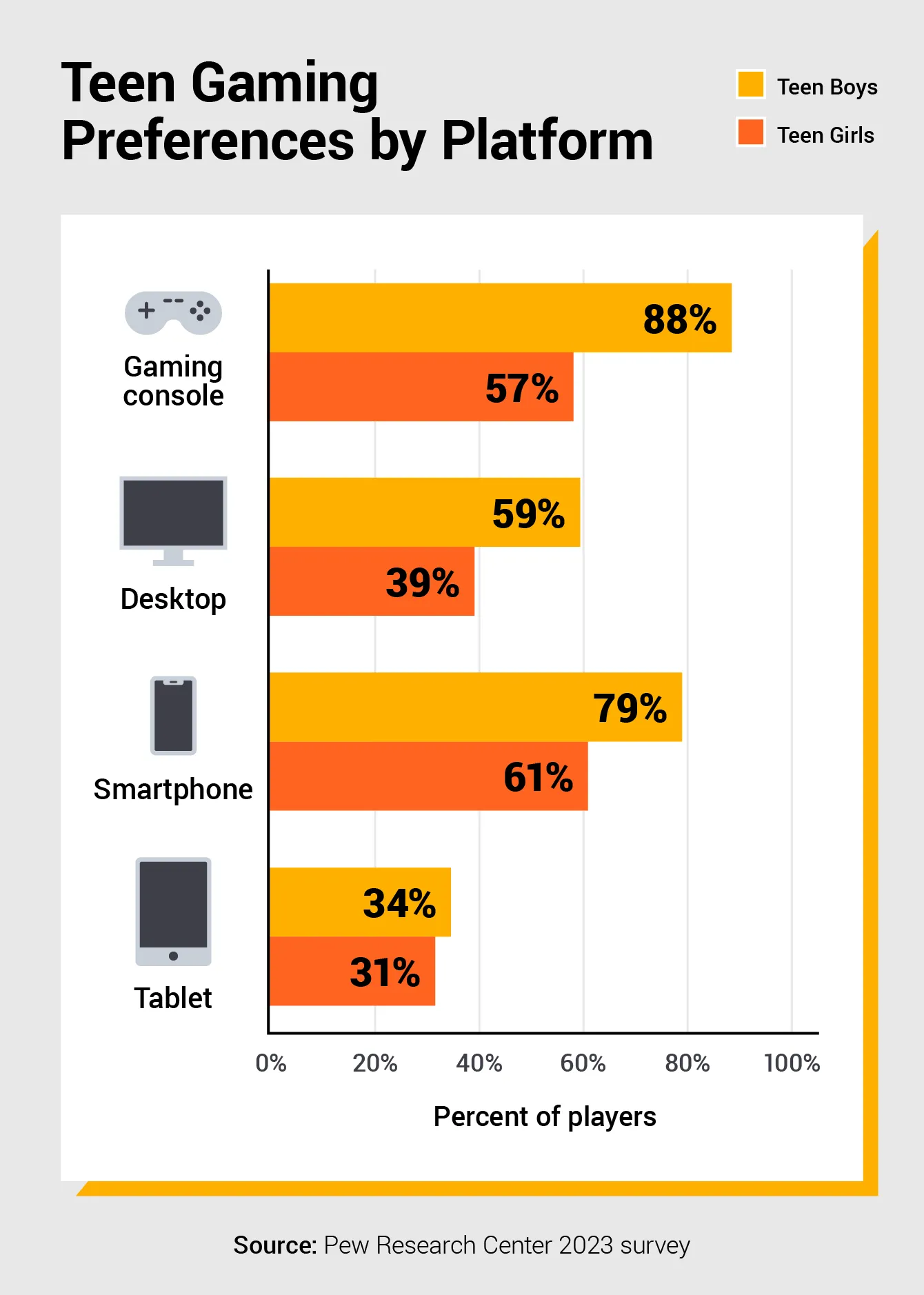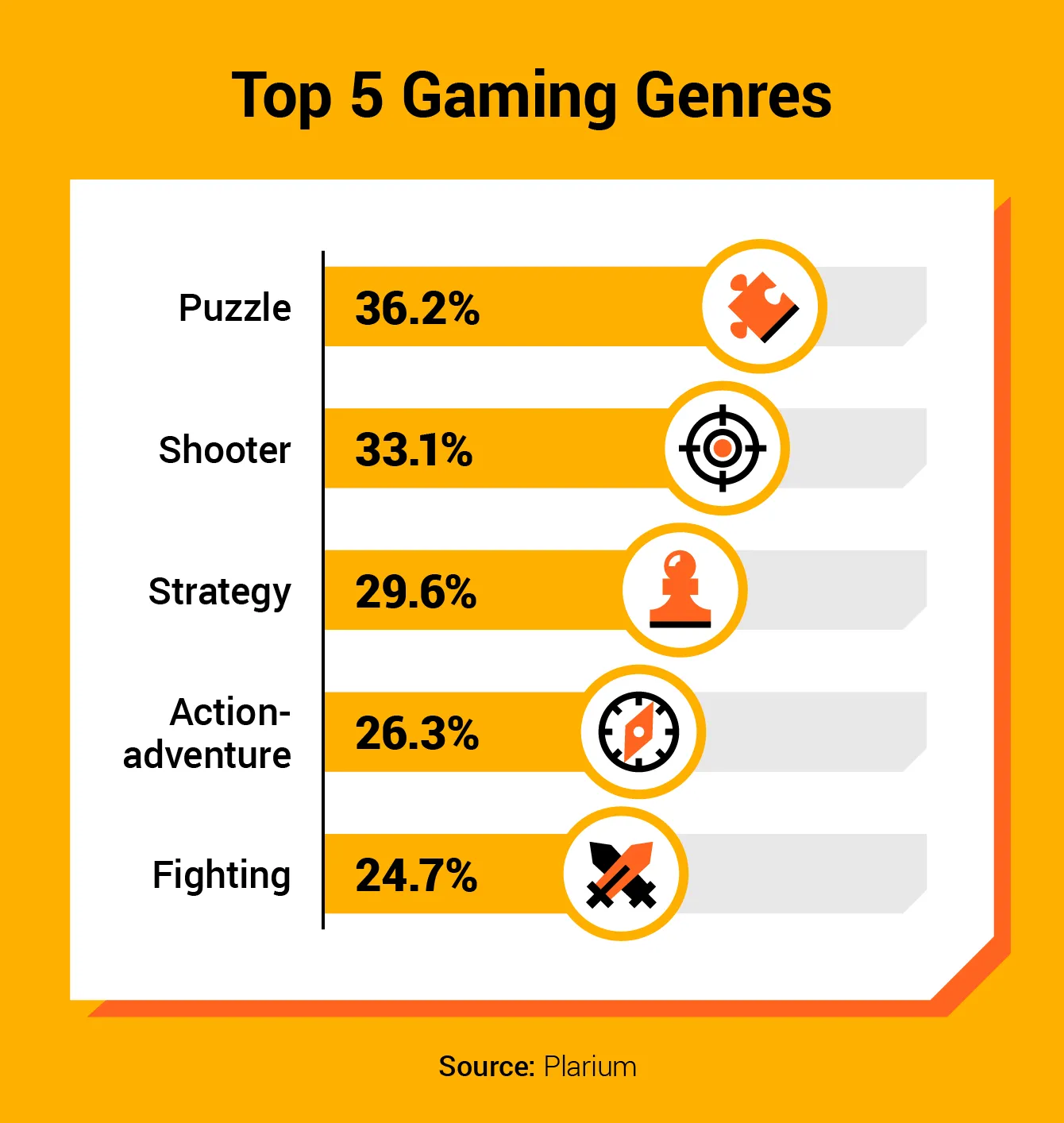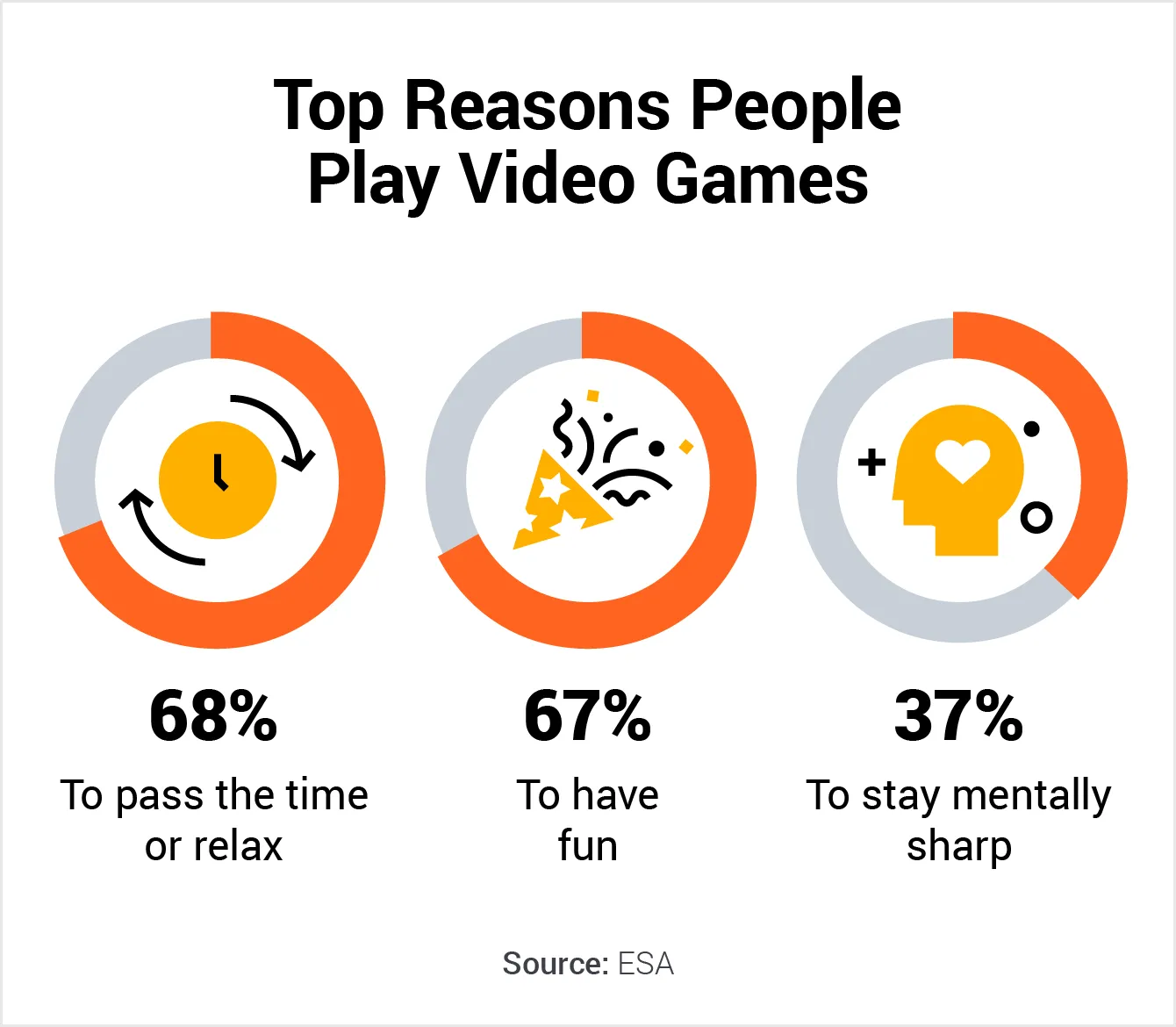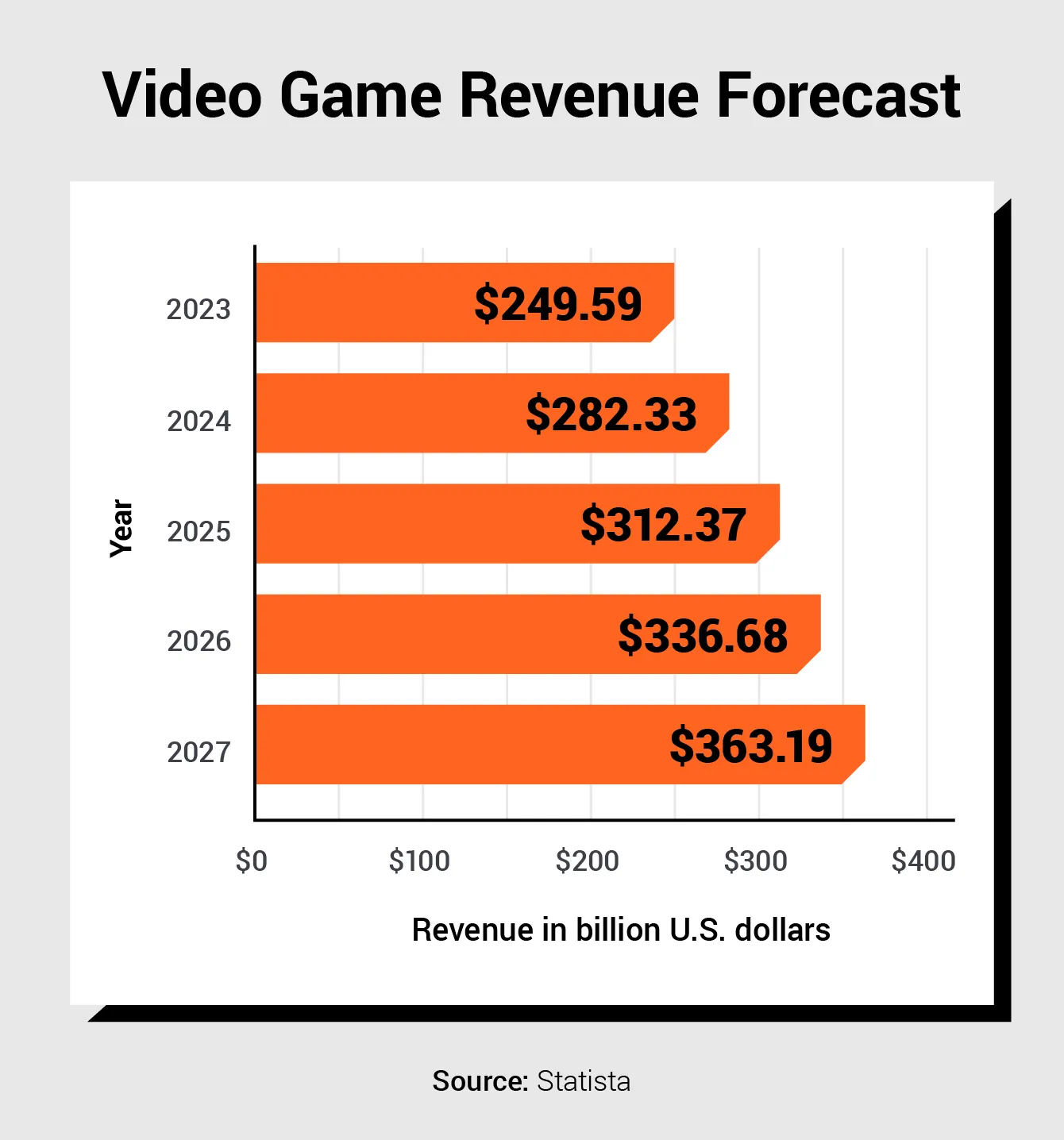
With 2.7 billion global gamers, playing video games has evolved from a niche hobby into a global entertainment powerhouse. From the immersive worlds of console and PC games to the addictive simplicity of mobile games, the influence of video games has permeated nearly every aspect of modern life, from social life to mental health.
As we delve into these 50 compelling video game industry statistics, you’ll see just how massive and impactful the gaming world has become. To complement industry-wide data, we’ve also included video game stats from our 2025 Gaming Trends Survey, which captured responses from over 1,000 U.S. gamers to reveal what’s really shaping player behavior today.
Video Game Statistics by Gender
A 2024 Newzoo study found that roughly 45% of all gamers are women and 55% are men, but we wanted to dig deeper. Some of our most interesting data revealed clear differences in how men and women engage with video games, from preferred game modes to career aspirations:
- Female gamers show a strong preference for single-player games, with 61.9% choosing them compared to 51.2% of men.
- Over 35% of men said they prefer multiplayer gaming, and only 24.5% of women said the same.
- Content creation is also a more popular aspiration among men, with 49.2% expressing moderate to extreme interest in becoming a gaming content creator, compared to 36% of women.
- When it comes to favorite genres, women are far more likely to prefer puzzle games (49.9%) and simulation games (24.4%), while shooter games are significantly more popular among men (41.2%).
Social Gaming Statistics
We discovered that although most gamers prefer single-player games, social interaction is a key factor for many gamers:
- About 57% of gamers prefer single-player games, yet 57.3% of those players say the social aspect still significantly impacts their enjoyment.
- Competition is a major motivator, with 31.6% of online multiplayer players saying they play primarily to achieve high rankings.
- Roughly 30% of players say they play online games to connect socially, either with friends they met in-game or from outside their gaming circles.
- Only 26% of gamers over the age of 60 value the social aspect of gaming.
Gamer Frustration Statistics
Our Gaming Trends Survey asked gamers to rank their top frustrations in online games, and the results highlight just how much technical performance and user experience affect player satisfaction:
- Glitches and bugs are the top frustration for 47% of gamers.
- Roughly 46% of players say in-game ads are a major frustration, making them the second most common complaint.
- Server lag is a major annoyance for 34.4% of gamers.
- Toxic or unsportsmanlike behavior is a frustration for 29.1% of players.
- Additional top frustrations include games being too hard (28%), games being too easy (13.1%), unbalanced gameplay (21.7%), and lack of skill expression (17.5%).
Video Game Statistics by Platform
From console and PC to mobile gaming, these figures highlight players’ gaming platform preferences and trends.
- Most teens report playing video games on a gaming console, with 73% using devices like PlayStation, Switch, or Xbox. (Pew Research Center)
- The most popular gaming platform in the U.S. is mobile at 67%, followed by PC (53%), console (36%), and VR (12%). (ESA)
- 44% of teen gamers use Discord, and 30% use Twitch. (Pew Research Center)
- Teen boys are more likely than girls to play video games on all devices except tablets. (Pew Research Center)
- Nearly 20% of gamers play games on mobile devices, PC, and console. (ESA)

Gamer Preference Statistics
Player preferences continue to evolve alongside the gaming landscape as a whole. Our survey data highlights what gamers value most in games and which genres are the most popular:
- Idle RPGs saw a 60% increase in downloads year over year, with games like Hero Wars: Alliance driving this growth. (Sensor Tower)
- Puzzle (36.2%), shooter (33.1%), and strategy (29.6%) games are the top three favorite genres among gamers. (Plarium)
- A compelling storyline is one of the most important factors to 60.2% of gamers when deciding whether to purchase a single-player game. (Plarium)
- Stunning graphics influence 70.2% of gamers to try a game, even if the gameplay appears mediocre. (Plarium)
- Over 75% of gamers rate cross-platform play as moderately to extremely important when choosing what to play. (Plarium)
Video Game Usage Statistics
This section dives into how players engage with video games, offering insights into average playtime, the most-played and least-played games, and the popularity of different genres.
- Over 90% of Gen Alpha and Gen Z consumers play video games. (Newzoo)
- Around 38% of gamers say they’ve cut back on their gaming time, while 61% have not reduced it at all. (Pew Research Center)
- 68% of gamers say they primarily play video games to pass the time or relax. (ESA)
- Around 40% of U.S. teens play video games daily, with 23% playing multiple times a day. (Pew Research Center)
- In December of 2024, Fortnite gaming streams and events on Twitch were watched for a total of 74.3 million hours. (Statista)

The Impact of Video Games on Society
Video games have a significant impact on both individuals and society, influencing everything from cognitive development and social interaction to cultural representation and the global economy. The benefits extend beyond entertainment, shaping education, creativity, and even mental health.
- The average gamer is 36 years old. (ESA)
- Globally, 85% of people interact with video games, with 80% playing and 64% watching gaming content. (Newzoo)
- 73% of gamers believe that video games can help them find new friends. (ESA)
- 32% of U.S. teens say that playing video games has helped their mental health. (Pew Research Center)
- Younger players are particularly driven by the competitive and cooperative social aspects of gaming. (Newzoo)
- 68% of PC and console players say that inclusive storytelling and cultural representation are important factors when choosing games. (Newzoo)
- Children who played video games for three or more hours a day were quicker and more accurate on cognitive tasks than those who never played. (NIH)

Video Game Addiction Statistics
In this section, we’ll explore the statistics surrounding video game addiction, a growing concern as gaming becomes more popular.
- The global average for weekly gaming hours is 8.45. Chinese gamers spend the most time, with an average of 12.38 hours per week. (Acta Psychologica)
- Addicted gamers spend an average of 5.25 hours a week playing, while non-addicted gamers spend about 3.8 hours. (Acta Psychologica)
- Most studies have found that men are more frequently diagnosed with gaming addiction compared to women. (Acta Psychologica)
Video Game Statistics by Revenue
From blockbuster game sales to the booming market for in-game purchases, these figures provide a clear picture of the economic power driving the gaming world.
- The highest-grossing mobile game of 2024 was the MOBA Honor of Kings, making $2.6 billion. (AppMagic)
- Mobile gaming in-app purchases in 2024 were $81.7 billion, a 3.9% increase from 2023. (Sensor Tower)
- In 2023, mid-core genres like RPGs, strategy, and shooting games saw a 1.2% increase in downloads year over year. (Sensor Tower)
- The video game market is projected to generate a staggering $522.46 billion in revenue by the end of 2025. (Statista)
- The average revenue per user (ARPU) in the video game market is predicted to be $1,840 by the end of 2025. (Statista)
- In 2024, MONOPOLY GO! generated the most revenue in North America. (Sensor Tower)
- In 2024, MONOPOLY GO! was the top-performing video game, with over $2.5 billion in revenue. (Sensor Tower)
- VR gaming revenues are projected to grow at a CAGR of 31.5% between 2025 and 2029. (Research and Markets)
- As of January 2025, Minecraft was the best-selling video game of all time, with 300 million copies sold. (Statista)
- Nearly 40% of gamers say loot boxes should be subject to age restrictions, and 32% say they’re exploitative and shouldn’t exist. (Plarium)
- In 2023, about 95% of gaming companies were either running live service games or were in the process of making one. (Griffin Gaming Partners)
- In-game purchases, or “microtransactions,” made up 58% of all PC gaming revenue in 2024. (Newzoo)

How the Video Game Industry Transcends Entertainment
The video game industry is doing way more than just entertaining — it’s having a huge impact on younger generations’ social lives. For many kids and teens, gaming is more than a hobby; it’s a way to connect with friends, explore new worlds, and learn new skills. Games like Minecraft and Fortnite have become social spaces where players hang out, collaborate, and even build entire communities, breaking down geographical boundaries.
Video games are also becoming a tool for learning. Schools use game-based learning because it keeps students engaged in ways that traditional methods might not. Games help children improve their problem-solving skills, creativity, and even hand-eye coordination.
The gaming industry isn’t just shaping minds — it’s also a major player in the global economy, creating jobs and driving tech innovation. With eSports on the rise, gaming is turning into a legit career path for many young people.
Explore a wide range of video games and start your adventure today!
Video Game FAQ
What Is the Biggest Video Game Developer?
By June 2025, Nintendo ranked as the largest gaming company by market cap, reaching $106.9 billion. Headquartered in Kyoto, Japan, this multinational company develops and publishes video games and gaming consoles.
How Common Is Gaming Addiction?
Researchers estimate that video game addiction affects 1.7% to 10% of the U.S. population. The wide range is due to differing opinions on the diagnostic criteria for internet gaming disorder.
What Age Group Is Most Affected by Video Games?
The majority of addicted gamers are adolescents and young adults, primarily falling within the 18-34 age range.
What Percentage of the World Are Gamers?
With a global population of around 8 billion and more people embracing gaming, over 40% of the world’s population are gamers.
Is 3 Hours of Gaming a Day Okay?
The answer to this is subjective, as what feels “okay” for one person might not feel okay for another. That said, a gaming session lasting between two and three hours appears to be the sweet spot for gamers to feel satisfied and perform at their best.











